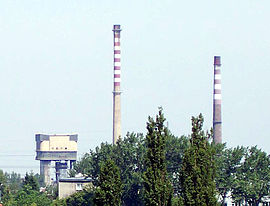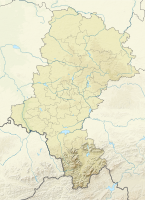Kopalnia Węgla Kamiennego Wujek
| Kopalnia Węgla Kamiennego "Wujek" | |||
|---|---|---|---|
| General information about the mine | |||
| Wujek mine | |||
| Mining technology | Civil engineering | ||
| Funding / year | 2,720,000 t | ||
| Information about the mining company | |||
| Operating company | Katowicki Holding Węglowy | ||
| Employees | 4,553 | ||
| Start of operation | 1899 | ||
| Funded raw materials | |||
| Degradation of | Hard coal | ||
| Geographical location | |||
| Coordinates | 50 ° 14 '41.2 " N , 18 ° 59' 16.6" E | ||
|
|||
| Location | ul.Wincentego Pola 36 | ||
| local community | Katowice | ||
| Voivodeship | Silesian Voivodeship | ||
| Country | Poland | ||
| District | Upper Silesian coal field | ||
The coal mine "Wujek" (Pol Wujek Coal Mine. Uncle , uncle , however German Oheimgrube ) is to Katowicki Holding Węglowy belonging Polish coal mine in Katowice .
history
The Wujek mine in Katowice-Brynów was founded partly in 1842 and partly in 1899. There has been mining activity in this area since the late 18th century; In 1788 Wilhelm Jaenkner founded the Charlotte coal mine near Załęska Hałda . Then in 1801 Johann Ferdinand Kohlhaas received the right to mine his land near Katowice and founded the Beata mine . This colliery mined from 1801 to 1806 and, after an interruption, from 1836 to 1880. Later it was merged with five other collieries to form "Wujek", but initially had the German name Oheim. This part was founded in 1842 by Albert von Sallay and Franz Winckler. After several changes of ownership of Sallay's share, the Oheim union was founded in 1895, the majority owner of which was the Prince of Hohenlohe-Oehringen. In 1905 Hohenlohe-Werke AG took over 501 of the union's 1,000 shares. The equipment for coal mining began in 1899 and in 1900 the first coal could be unearthed after the overburden in Zalenzer Halde / Załęska Hałda had been successfully explored. Up to a depth of 306 meters, five seams with thicknesses between 1.2 m and 4.2 m were encountered. There had been mining activities in this area since the end of the 18th century, which ended in 1788 in the Charlotte coal mine, founded by Wilhelm Jaenkner. In 1801 Johann Ferdinand Kohlhaas was also given the right to mine his land near Katowice and founded the Beate mine. Together with Albert, Victor, Bonin, Praeservativ and Kleine Helene, she formed a joint venture with uncle, so that she had a field the size of 4.64 km². To the south the mining area was bounded by the mining area of the free estate of Pleß, to the east by the property of the heirs of Giesche. The first shafts sunk on the uncle field itself were Hohenlohe (later Lechia) and Kramsta (later Krakus), and in 1907 a weather shaft was added on the company premises. By 1912, 29 seams with a total thickness of 31.3 meters had been developed or explored.
In 1918/1919 social reforms were decided for the miners . So was z. B. working hours are limited to eight hours per day. The bill came to a focal point during the Silesian Uprisings and was the newly created after the division of Upper Silesia Bergamt assumed Katowice. In 1922 the colliery had 4,016 employees. In 1939 the mine was occupied by the German armed forces. On January 23, 1945 the last soldiers of the Wehrmacht left the mine. The war damage began to be repaired immediately. Prisoners of war were also used for this purpose. At the end of the 1970s, over 6,000 people were employed in the mine.
1980s
During the strikes in August 1980 there were also work stoppages at the Wujek colliery . These ended on September 3, 1980 with the signing of an agreement between the government and the strikers.
“Pacification” of the occupation strike in 1981
After martial law was imposed in Poland on December 13, 1981 and the chairman of the local Solidarność was arrested , an occupation strike took place in the mine on December 14, 1981. On December 15, 1981, police and army units were concentrated in the vicinity of the colliery. The violent suppression of the protest, supported by tanks, began on the morning of December 16, 1981. During the storming of the colliery, members of the ZOMO special police unit shot and killed nine miners and injured 21.
consequences
In 1982, 1997, 1999, 2002 and 2007 there were different trials around the events of December 16, 1981; these ended with discontinuation or, on resumption, with prison sentences.
Commemoration
On December 15, 1991, a memorial cross for the miners killed in the pacification of 1981 (Polish: Pomnik poległych górników KWK Wujek ) was erected on the mine site .
The events of December 1981 were filmed in the film Śmierć jak kromka chleba (Death is like a slice of bread) directed by Kazimierz Kutz in 1994.
In December 2008, a memorial museum was opened on the mine site.
After 1990
On March 1, 1993, the mine was transformed from a state-owned company into a private company owned by the Polish Ministry of Finance. The entrepreneurial independence was terminated on June 2nd of the same year, and the colliery became part of Katowicki Holding Węglowy .
On January 1, 2005, the Wujek and KWK Śląsk mines in Ruda Śląska merged to form Kopalnia Węgla Kamiennego "Wujek" with the two production sites Ruch Śląsk and Ruch Wujek.
In a methane gas explosion at a depth of 1050 meters in 2009, 20 miners were killed and over 30 were injured.
On January 5, 2012, a fire broke out at a depth of 700 m; the extinguishing work was completed three days later. Because of the fire, there were considerations at the beginning of 2012 to close the mine. However, these considerations currently (2015) seem to be off the table.
After a mountain attack in 2015 that killed two miners, the Śląsk department was shut down at the beginning of 2018.
"Wujek" today
4,553 people are employed in the merged Kopalnia Węgla Kamiennego “Wujek” Ruch Wujek (as of April 2012). The daily extraction rate is 1,000 tons and the annual output is 2,720,000 tons. The stock of coal that can still be mined is put at 60,050,000 tons. On April 1st, 2012 Adam Zelek took over the management of the colliery.
Funding figures
- 1913: 622,782 tons
- 1938: 1.21 million tons
- 1970: 2.09 million t
- 1979: 3.82 million t
- 2014: 2.53 million t
References to the supplements
- Jerzy Jaros: Słownil histoynczny kolapń węgla na ziemiach polskich . Katowice 1984.
- Yearbook for the Upper Mining District Wroclaw . Phönix-Verlag, Kattowitz / Breslau / Berlin 1913, digitized version at http://www.dbc.wroc.pl/dlibra/publication?id=3349&tab=3 (last accessed on May 5, 2015).
- At the Internet address http://igrek.amzp.pl/mapindex.php?cat=FLOTZKARTOS (last accessed July 14, 2015) you can find 43 flötz maps (sic) of the Upper Silesian coal basin as JPG files showing the field boundaries, seams and shafts show the stock from 1902 in excellent quality. These cards were issued by the “Verlag von Priebatsch's Buchhandlung Breslau”.
Web links
- Website of the colliery
- Wujek Museum website (Polish)
- Katowicki Holding Węglowy website
- Gazeta Katowice image archives with images from December 16, 1981 (Polish)
Footnotes
- ↑ Czołgi na Wujek jadą! December 12, 2011, Retrieved April 28, 2012 (Polish).
- ^ Friedrich-Christian Schroeder : The legal processing of the communist past in Eastern Europe . In: Herbert Küpper (Ed.): Studies of the Institute for Eastern Law Munich . tape 63 . Peter Lang, Frankfurt 2010, ISBN 978-3-631-59611-1 , Kopalnia Wujek, so-called pacification of the strikers 1981, p. 140 .
- ↑ Smierc jak kromka chleba - Death is like a slice of bread. In: drama-film.de. Retrieved May 12, 2015 (film info).
- ↑ Krzyż - pomnik górników KWK Wujek Wujek. (No longer available online.) In: muzeum-wujek.pl. Archived from the original on February 21, 2015 ; Retrieved May 12, 2015 (Polish). Info: The archive link was inserted automatically and has not yet been checked. Please check the original and archive link according to the instructions and then remove this notice.
- ↑ "Wujek" Katowicko-rudzkie centrum wydobywcze na prostej 2007-01-13 ( Memento of 27 September 2007 at the Internet Archive ) In: teberia.pl , accessed 4 January 2012 (Polish)
- ↑ Informacje z woj. śląskiego. In: tvs.pl. March 10, 2009, accessed May 12, 2015 (Polish).
- ↑ W kopalni dopuszczano do pracy niesprawne maszyny. In: katowice.gazeta.pl. October 22, 2011, accessed May 12, 2015 (Polish).
- ↑ KHW: akcja pożarowa w kopalni Wujek - Gornictwo. In: gornictwo.wnp.pl. January 5, 2012, accessed May 12, 2015 (Polish).
- ↑ Kopalnia Wujek może przestać istnieć. In: katowice.gazeta.pl. February 21, 2012, accessed May 12, 2015 (Polish).
- ↑ Katowicki Holding Węglowy: reperacja kopalni Wujek - Gornictwo. In: gornictwo.wnp.pl. April 26, 2012, accessed May 12, 2015 (Polish).
- ↑ PGG Magazyn February 2018, p. 10. Access under http://pgg.pl/files/biezace/art493/PGG201802.pdf on March 17, 2018
- ↑ Adam Zelek Nowym Szefém kopalni Wujek - Górnictwo. In: gornictwo.wnp.pl. April 1, 2012, accessed May 12, 2015 (Polish).



